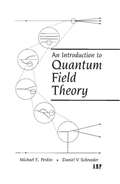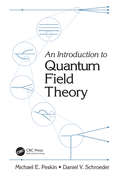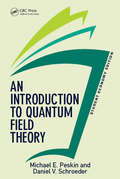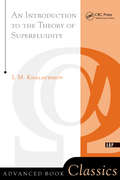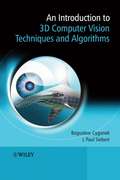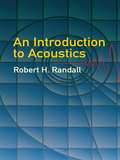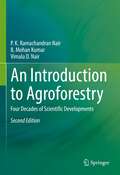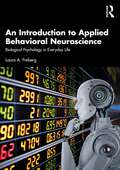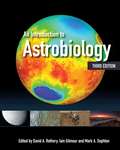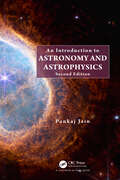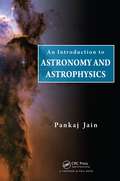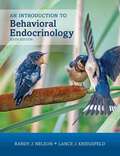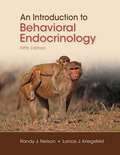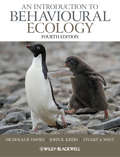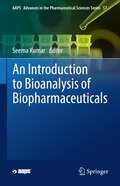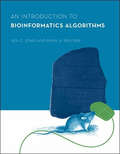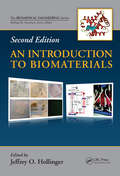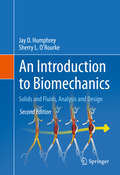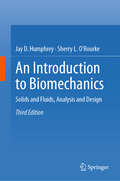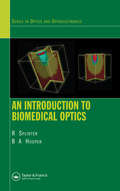- Table View
- List View
An Introduction To Quantum Field Theory
by Michael E. Peskin Daniel V. SchroederAn Introduction to Quantum Field Theory is a textbook intended for the graduate physics course covering relativistic quantum mechanics, quantum electrodynamics, and Feynman diagrams. The authors make these subjects accessible through carefully worked examples illustrating the technical aspects of the subject, and intuitive explanations of what is going on behind the mathematics. After presenting the basics of quantum electrodynamics, the authors discuss the theory of renormalization and its relation to statistical mechanics, and introduce the renormalization group. This discussion sets the stage for a discussion of the physical principles that underlie the fundamental interactions of elementary particle physics and their description by gauge field theories.
An Introduction To Quantum Field Theory
by Michael E. Peskin Daniel V. SchroederAn Introduction to Quantum Field Theory is a textbook intended for the graduate physics course covering relativistic quantum mechanics, quantum electrodynamics, and Feynman diagrams. The authors make these subjects accessible through carefully worked examples illustrating the technical aspects of the subject, and intuitive explanations of what is going on behind the mathematics. After presenting the basics of quantum electrodynamics, the authors discuss the theory of renormalization and its relation to statistical mechanics, and introduce the renormalization group. This discussion sets the stage for a discussion of the physical principles that underlie the fundamental interactions of elementary particle physics and their description by gauge field theories.
An Introduction To Quantum Field Theory
by Michael E. Peskin Daniel V. SchroederAn Introduction to Quantum Field Theory is a textbook intended for the graduate physics course covering relativistic quantum mechanics, quantum electrodynamics, and Feynman diagrams. The authors make these subjects accessible through carefully worked examples illustrating the technical aspects of the subject, and intuitive explanations of what is going on behind the mathematics. After presenting the basics of quantum electrodynamics, the authors discuss the theory of renormalization and its relation to statistical mechanics, and introduce the renormalization group. This discussion sets the stage for a discussion of the physical principles that underlie the fundamental interactions of elementary particle physics and their description by gauge field theories.
An Introduction To Quantum Field Theory, Student Economy Edition (Frontiers in Physics)
by Michael Peskin"An Introduction to Quantum Field Theory" is a textbook intended for the graduate physics course covering relativistic quantum mechanics, quantum electrodynamics, and Feynman diagrams. The authors make these subjects accessible through carefully worked examples illustrating the technical aspects of the subject, and intuitive explanations of what is going on behind the mathematics. After presenting the basics of quantum electrodynamics, the authors discuss the theory of renormalization and its relation to statistical mechanics, and introduce the renormalization group. This discussion sets the stage for a discussion of the physical principles that underlie the fundamental interactions of elementary particle physics and their description by gauge field theories.
An Introduction To The Theory Of Superfluidity (Advanced Books Classics Ser.)
by Isaac M. KhalatnikovA classic from 1965, this book covers the main aspects of the theory of quantum liquids, including the elementary excitation spectrum, hydrodynamics, and kinetic phenomena. The book requires no special training and assumes only general knowledge of the fundamentals of theoretical physics. It was developed from studies at the Institute of Physical Problems of the U.S.S.R. Academy of Sciences and can be used as a guide for professors teaching quantum liquid theory or as a text for graduate students.
An Introduction to 3D Computer Vision Techniques and Algorithms
by Boguslaw Cyganek J. Paul SiebertComputer vision encompasses the construction of integrated vision systems and the application of vision to problems of real-world importance. The process of creating 3D models is still rather difficult, requiring mechanical measurement of the camera positions or manual alignment of partial 3D views of a scene. However using algorithms, it is possible to take a collection of stereo-pair images of a scene and then automatically produce a photo-realistic, geometrically accurate digital 3D model.This book provides a comprehensive introduction to the methods, theories and algorithms of 3D computer vision. Almost every theoretical issue is underpinned with practical implementation or a working algorithm using pseudo-code and complete code written in C++ and MatLab®. There is the additional clarification of an accompanying website with downloadable software, case studies and exercises. Organised in three parts, Cyganek and Siebert give a brief history of vision research, and subsequently: present basic low-level image processing operations for image matching, including a separate chapter on image matching algorithms;explain scale-space vision, as well as space reconstruction and multiview integration;demonstrate a variety of practical applications for 3D surface imaging and analysis;provide concise appendices on topics such as the basics of projective geometry and tensor calculus for image processing, distortion and noise in images plus image warping procedures.An Introduction to 3D Computer Vision Algorithms and Techniques is a valuable reference for practitioners and programmers working in 3D computer vision, image processing and analysis as well as computer visualisation. It would also be of interest to advanced students and researchers in the fields of engineering, computer science, clinical photography, robotics, graphics and mathematics.
An Introduction to Acoustics (Dover Books on Physics)
by Robert H. RandallNo branch of classical physics is older in its origins yet more modern in its applications than acoustics. Courses on acoustics very naturally begin with a study of vibrations, as a preliminary to the introduction of the wave equations. Both vibrations and waves, of course, are vastly important to all branches of physics and engineering. But it is very helpful to students to gain an understanding of mechanical waves before trying to comprehend the more subtle and abstract electromagnetic ones.This undergraduate-level text opens with an overview of fundamental particle vibration theory, and it proceeds to examinations of waves in air and in three dimensions, interference patterns and diffraction, and acoustic impedance, as illustrated in the behavior of horns. Subsequent topics include longitudinal waves in different gases and waves in liquids and solids; stationary waves and vibrating sources, as demonstrated by musical instruments; reflection and absorption of sound waves; speech and hearing; sound measurements and experimental acoustics; reproduction of sound; and miscellaneous applied acoustics. Supplementary sections include four appendixes and answers to problems. Introduction. Appendixes. List of Symbols. References. Index. Answers to Problems.
An Introduction to Agroforestry: Four Decades of Scientific Developments
by Vimala D. Nair B. Mohan Kumar P. K. NairAgroforestry – the practice of growing trees and crops in interacting combinations – is recognized the world over as an integrated approach to sustainable land-use. Agroforestry systems, being multifunctional, facilitate not only the production of food and wood products but also provide a variety of ecosystem services such as climate-change mitigation, biodiversity conservation, and soil quality improvement. Agroforestry research has made rapid strides since organized efforts started in the late 1970s. Today, a vast body of scientific knowledge and an impressive array of publications on agroforestry are available. Four World Congresses on Agroforestry conducted once every five years since 2004 have brought together the global community of agroforestry professionals and practitioners to share and discuss the emerging trends and paradigm shifts in this field. The fifth Congress is scheduled to be held in Québec, Canada. However, a comprehensive college-level textbook incorporating these research findings did not exist until this book was first published. The first edition of this book in 1993 (Nair, P. K. R., 1993) is out of print and somewhat dated. This revised edition, with emphasis on the scientific developments during the past more than four decades, addresses this long-felt need.
An Introduction to Animal Behaviour
by Aubrey Manning Marian Stamp DawkinsWolves excitedly greet each other as members of the pack come together; a bumble bee uses its long tongue to reach the nectar at the base of a foxglove flower; a mongoose swiftly and deftly bites its prey to death; young cheetahs rest quietly together, very close to sleep. Now in full colour, this revised and updated edition of Manning and Dawkins' classic text provides a beautifully written introduction to the fundamentals of animal behaviour. Tinbergen's four questions of causation, evolution, development and function form the fundamental framework of the text, illustrated with fascinating examples of complex behavioural mechanisms. The authors provide accounts of all levels of behaviour from the nerve cell to that of the population. The strengths of An Introduction to Animal Behaviour as a textbook include its clear explanations and concise, readable text and the enthusiasm of the authors for their subject.
An Introduction to Applied Behavioral Neuroscience: Biological Psychology in Everyday Life
by Laura A. FrebergAn Introduction to Applied Behavioral Neuroscience explores the connection between neuroscience and multiple domains, including psychological disorders, forensics, education, consumer behavior, economics, leadership, health, and robotics and artificial intelligence. The book ensures students have a solid foundation in the history of behavioral neuroscience; its applicability to other facets of science and policy, and a good understanding of major methodologies and their limitations to aiding critical thinking skills. Written in a student-friendly style, it provides a highly accessible introduction to the major structural and functional features of the human nervous system. It then discusses applications across a variety of areas in society, including how behavioral neuroscience is used by the legal system, in educational practice, advertising, economics, leadership, the development of and recovery from health challenges, and in robotics. Each of the application-specific chapters present the problems that neuroscience is being asked to address, the methods being used, and the challenges and successes experienced by scholars and practitioners in each domain. It is a must-read for all advanced undergraduate and postgraduate students in biological psychology, neuroscience, and clinical psychology who want to know what neuroscience can really do to address real-world problems.
An Introduction to Applied Behavioral Neuroscience: Biological Psychology in Everyday Life
by Laura A. FrebergAn Introduction to Applied Behavioral Neuroscience explores the connection between neuroscience and multiple domains, including psychological disorders, forensics, education, consumer behavior, economics, leadership, health, and robotics and artificial intelligence. The book ensures students have a solid foundation in the history of behavioral neuroscience; its applicability to other facets of science and policy, and a good understanding of major methodologies and their limitations to aiding critical thinking skills. Written in a student-friendly style, it provides a highly accessible introduction to the major structural and functional features of the human nervous system. It then discusses applications across a variety of areas in society, including how behavioral neuroscience is used by the legal system, in educational practice, advertising, economics, leadership, the development of and recovery from health challenges, and in robotics. Each of the application-specific chapters present the problems that neuroscience is being asked to address, the methods being used, and the challenges and successes experienced by scholars and practitioners in each domain. It is a must-read for all advanced undergraduate and postgraduate students in biological psychology, neuroscience, and clinical psychology who want to know what neuroscience can really do to address real-world problems.
An Introduction to Astrobiology
by David A. Rothery Iain Gilmour Mark A. SephtonHow did life on Earth begin? How common is it elsewhere in the Universe? Written and edited by planetary scientists and astrobiologists, this undergraduate-level textbook provides an introduction to the origin and nature of life, the habitable environments in our solar system and the techniques most successfully used for discovery and characterisation of exoplanets. This third edition has been thoroughly revised to embrace the latest developments in this field. Updated topics include the origins of water on Earth, the exploration of habitable environments on Mars, Europa and Enceladus, and the burgeoning discoveries in exoplanetary systems. Ideal for introductory courses on the subject, the textbook is also well-suited for self-study. It highlights important concepts and techniques in boxed summaries, with questions and exercises throughout the text, with full solutions provided. Online resources, hosted at www.cambridge.org/features/planets, include selected figures from the book, self-assessment questions and sample tutor assignments.
An Introduction to Astronomy and Astrophysics
by Pankaj JainAstronomy is the field of science devoted to the study of astronomical objects, such as stars, galaxies, and nebulae. Astronomers have gathered a wealth of knowledge about the universe through hundreds of years of painstaking observations. These observations are interpreted by the use of physical and chemical laws familiar to mankind. These interpretations supply information about the nature of these astronomical objects, allowing for the deduction of their surface and interior conditions. The science associated with these interpretations is called astrophysics.An Introduction to Astronomy and Astrophysics offers a comprehensive introduction to astronomy and astrophysics, complete with illustrative examples and illuminating homework problems. Requiring a familiarity with basic physics and mathematics, this undergraduate-level textbook: Addresses key physics concepts relevant to stellar observations, including radiation, electromagnetic spectrum, photometry, continuous and discrete spectrum, and spectral lines. Describes instruments used for astronomical observations as well as how the radiation received is characterized and interpreted to determine the properties of stars. Examines the structure of stars, the basic equations that explain stars in equilibrium, and the fusion reactions occurring in stellar cores. Discusses the evolution of stars, the solar system, the dynamics of galaxies, and the fundamentals of modern cosmology. Explores the universe at high redshifts, where it is dominated by objects such as active galaxies. An Introduction to Astronomy and Astrophysics teaches students how to interpret the night sky, providing them with a critical understanding of the stars and sun, solar system, extrasolar planets, stars, and galaxies.The book is thoroughly revised to make it an essential textbook for students. The Second edition introduces the following changes: New solutions are provided at the end of all the chapters. The number of problems has increased. Major chapters have been considerably revised and new developments in this field have been introduced.
An Introduction to Astronomy and Astrophysics
by Pankaj JainAstronomy is the field of science devoted to the study of astronomical objects, such as stars, galaxies, and nebulae. Astronomers have gathered a wealth of knowledge about the universe through hundreds of years of painstaking observations. These observations are interpreted by the use of physical and chemical laws familiar to mankind. These interpr
An Introduction to Atmospheric Thermodynamics
by Anastasios A. TsonisThis is a self-contained, concise, rigorous book introducing the reader to the basics of atmospheric thermodynamics, and the author is a highly respected researcher in this field. This new edition has been brought completely up to date and reorganized to improve the quality and flow of the material. Each chapter contains worked examples and student exercises, making this an ideal text for short undergraduate courses taken as part of an atmospheric science, meteorology, physics or natural science program. Solutions available to lecturers.
An Introduction to Behavioral Endocrinology (Sinauer)
by Randy J. Nelson Lance J. KriegsfeldThe market-leading text, An Introduction to Behavioral Endocrinology, Sixth Edition provides an updated, integrated presentation of the study of hormone-behavior-brain interactions. Maintaining a comparative approach, the text explores the endocrine mechanisms that have evolved in both human and nonhuman animals to solve common problems in survival and reproduction. <p><p>The text describes interactions among hormones, brain, and behavior from a historical perspective, emphasizing connections among key theories and tracing the emergence of important hypotheses. The book is organized around the conceptual theme that hormones affect behavior by influencing one or more of three "components" of behaving animals--input mechanisms (such as sensory or perceptual processes), the central processing mechanisms of the nervous system (either directly, or by affecting its development or structure), and output mechanisms (such as effectors or peripheral structures). Despite increased coverage of molecular and cellular approaches, the book strives for accessibility for non-biological science students.
An Introduction to Behavioral Endocrinology, Fifth Edition
by Randy J. Nelson Lance J. KriegsfeldAn Introduction to Behavioral Endocrinology, Fifth Edition retains all of the features of the bestselling prior editions, and provides an updated, integrated presentation of the study of hormone-behavior-brain interactions.
An Introduction to Behavioural Ecology
by Nicholas B. Davies Stuart A. West John R. KrebsAdditional resources for this book can be found at: www.wiley.com/go/davies/behaviouralecologyThis textbook helped to define the field of Behavioural Ecology. In this fourth edition the text has been completely revised, with new chapters and many new illustrations and full colour photographs. The theme, once again, is the influence of natural selection on behaviour - an animal's struggle to survive and reproduce by exploiting and competing for resources, avoiding predators, selecting mates and caring for offspring, - and how animal societies reflect both cooperation and conflict among individuals.Stuart A. West has joined as a co-author bringing his own perspectives and work on microbial systems into the book.Written in the same engaging and lucid style as the previous editions, the authors explain the latest theoretical ideas using examples from micro-organisms, invertebrates and vertebrates. There are boxed sections for some topics and marginal notes help guide the reader. The book is essential reading for students of behavioural ecology, animal behaviour and evolutionary biology.Key Features:Long-awaited new edition of a field-defining textbookNew chapters, illustrations and colour photographsNew co-authorFocuses on the influence of natural selection on behavior, and how animal societies reflect both cooperation and conflict among individuals"The long-awaited update to a classic in this field is now here, presenting new directions in thinking and addressing burning questions. Richly informed by progress in many other disciplines, such as sensory physiology, genetics and evolutionary theory, it marks the emergence of behavioural ecology as a fully fledged discipline..... This is a marvellous book, written in a lucid style. A must-read for those in the field, it is also a cornucopia of new thinking for anyone interested in evolution and behaviour."Manfred Milinski, Nature, 2012
An Introduction to Behavioural Ecology
by Nicholas B. Davies Stuart A. West John R. KrebsThis textbook helped to define the field of Behavioural Ecology. In this fourth edition the text has been completely revised, with new chapters and many new illustrations and full colour photographs. The theme, once again, is the influence of natural selection on behaviour – an animal's struggle to survive and reproduce by exploiting and competing for resources, avoiding predators, selecting mates and caring for offspring, – and how animal societies reflect both cooperation and conflict among individuals. Stuart A. West has joined as a co-author bringing his own perspectives and work on microbial systems into the book. Written in the same engaging and lucid style as the previous editions, the authors explain the latest theoretical ideas using examples from micro-organisms, invertebrates and vertebrates. There are boxed sections for some topics and marginal notes help guide the reader. The book is essential reading for students of behavioural ecology, animal behaviour and evolutionary biology. Key Features: Long-awaited new edition of a field-defining textbook New chapters, illustrations and colour photographs New co-author Focuses on the influence of natural selection on behavior, and how animal societies reflect both cooperation and conflict among individuals “The long-awaited update to a classic in this field is now here, presenting new directions in thinking and addressing burning questions. Richly informed by progress in many other disciplines, such as sensory physiology, genetics and evolutionary theory, it marks the emergence of behavioural ecology as a fully fledged discipline….. This is a marvellous book, written in a lucid style. A must-read for those in the field, it is also a cornucopia of new thinking for anyone interested in evolution and behaviour.” Manfred Milinski, Nature, 2012
An Introduction to Bioanalysis of Biopharmaceuticals (AAPS Advances in the Pharmaceutical Sciences Series #57)
by Seema KumarThe book provides a comprehensive review of the fundamental and practical aspects of bioanalytical support and the integral role it plays in the development of safe and efficacious biopharmaceutical drugs with speed and cost-effectiveness. The book focuses on a broad range of conventional and emerging biopharmaceutical modalities including monoclonal antibody-based therapeutics, gene therapy, cell therapy, peptides and oligonucleotides. The book starts with an introductory overview of bioanalysis showcasing the integral role it plays in understanding the drug disposition (pharmacokinetics/pharmacodynamics and immunogenicity) and the progression of bioanalytical strategy as the drug progresses through discovery and development stages of the program, taking into consideration the continually evolving regulatory landscape. The book further diversifies into individual biopharmaceutical modalities - monoclonal antibodies, antibody-drug conjugates, bispecifics, Fc-fusion proteins, gene therapies, cell therapies, peptides and oligonucleotides. The individual chapters focus on modality-specific bioanalytical assay strategies, critical reagents, assay formats, analytical platforms, associated bioanalytical challenges and mitigation strategies, industry best practices, and the latest understanding of regulatory guidance as applicable to the fast-growing biopharmaceutical landscape.
An Introduction to Bioinformatics Algorithms (Computational Molecular Biology)
by Neil C. Jones Pavel A. PevznerAn introductory text that emphasizes the underlying algorithmic ideas that are driving advances in bioinformatics.This introductory text offers a clear exposition of the algorithmic principles driving advances in bioinformatics. Accessible to students in both biology and computer science, it strikes a unique balance between rigorous mathematics and practical techniques, emphasizing the ideas underlying algorithms rather than offering a collection of apparently unrelated problems. The book introduces biological and algorithmic ideas together, linking issues in computer science to biology and thus capturing the interest of students in both subjects. It demonstrates that relatively few design techniques can be used to solve a large number of practical problems in biology, and presents this material intuitively. An Introduction to Bioinformatics Algorithms is one of the first books on bioinformatics that can be used by students at an undergraduate level. It includes a dual table of contents, organized by algorithmic idea and biological idea; discussions of biologically relevant problems, including a detailed problem formulation and one or more solutions for each; and brief biographical sketches of leading figures in the field. These interesting vignettes offer students a glimpse of the inspirations and motivations for real work in bioinformatics, making the concepts presented in the text more concrete and the techniques more approachable.PowerPoint presentations, practical bioinformatics problems, sample code, diagrams, demonstrations, and other materials can be found at the Author's website.
An Introduction to Biomaterials (Biomedical Engineering)
by Jeffrey O. HollingerA practical road map to the key families of biomaterials and their potential applications in clinical therapeutics, Introduction to Biomaterials, Second Edition follows the entire path of development from theory to lab to practical application. It highlights new biocompatibility issues, metrics, and statistics as well as new legislation for intelle
An Introduction to Biomechanics: Solids and Fluids, Analysis and Design
by Jay D. Humphrey Sherry L. O'RourkeThis book covers the fundamentals of biomechanics. Topics include bio solids, biofluids, stress, balance and equilibrium. Students are encouraged to contextualize principles and exercises within a "big picture" of biomechanics. This is an ideal book for undergraduate students with interests in biomedical engineering.
An Introduction to Biomechanics: Solids and Fluids, Analysis and Design
by Jay D. Humphrey Sherry L. O’RourkeThis textbook introduces the student to a consistent approach of formulating and solving problems involving the biomechanics of solids and fluids. Brief introductions are also provided for more complex situations that require methods of nonlinear elasticity, elastodynamics, viscoelasticity, or fluid-solid interactions. Concepts are motivated by concise descriptions of important biological, biomechanical, and clinical observations and techniques. Included are over 300 figures and 200 references, as well as complete derivations of the fundamental equations, solutions of over 100 example problems, and over 350 exercise problems. Perfect for a one- or two-semester introduction to biomechanics, this Third Edition includes expanded sections on complex fluid (non-Newtonian) and solid (nonlinear and anisotropic) behaviors as well as coupled problems for different tissues. Additional homework problems encourage the student to appreciate the broad applicability of the fundamental equations. An Introduction to Biomechanics, Third Edition is an ideal book for undergraduate students with interests in bioengineering, biomedical engineering, or biomechanical engineering, and serves as a valuable reference for graduate students, practicing engineers, and researchers. This book also: Guides students in developing intuitive understanding via a consistent consideration of diverse problems including cardiovascular, musculoskeletal, pulmonary, and cell mechanics Encourages students to develop a “big picture” approach to problem-solving in biomechanics through chapter summaries Challenges students to solve problems for conditions commonly experienced in the laboratory, industry, or the clinic
An Introduction to Biomedical Optics (Series in Optics and Optoelectronics)
by Robert Splinter Brett A. HooperMany universities now offer a course in biomedical optics, but lack a textbook specifically addressing the topic. Intended to fill this gap, An Introduction to Biomedical Optics is the first comprehensive, introductory text describing both diagnostic and therapeutic optical methods in medicine. It provides the fundamental background needed for grad
